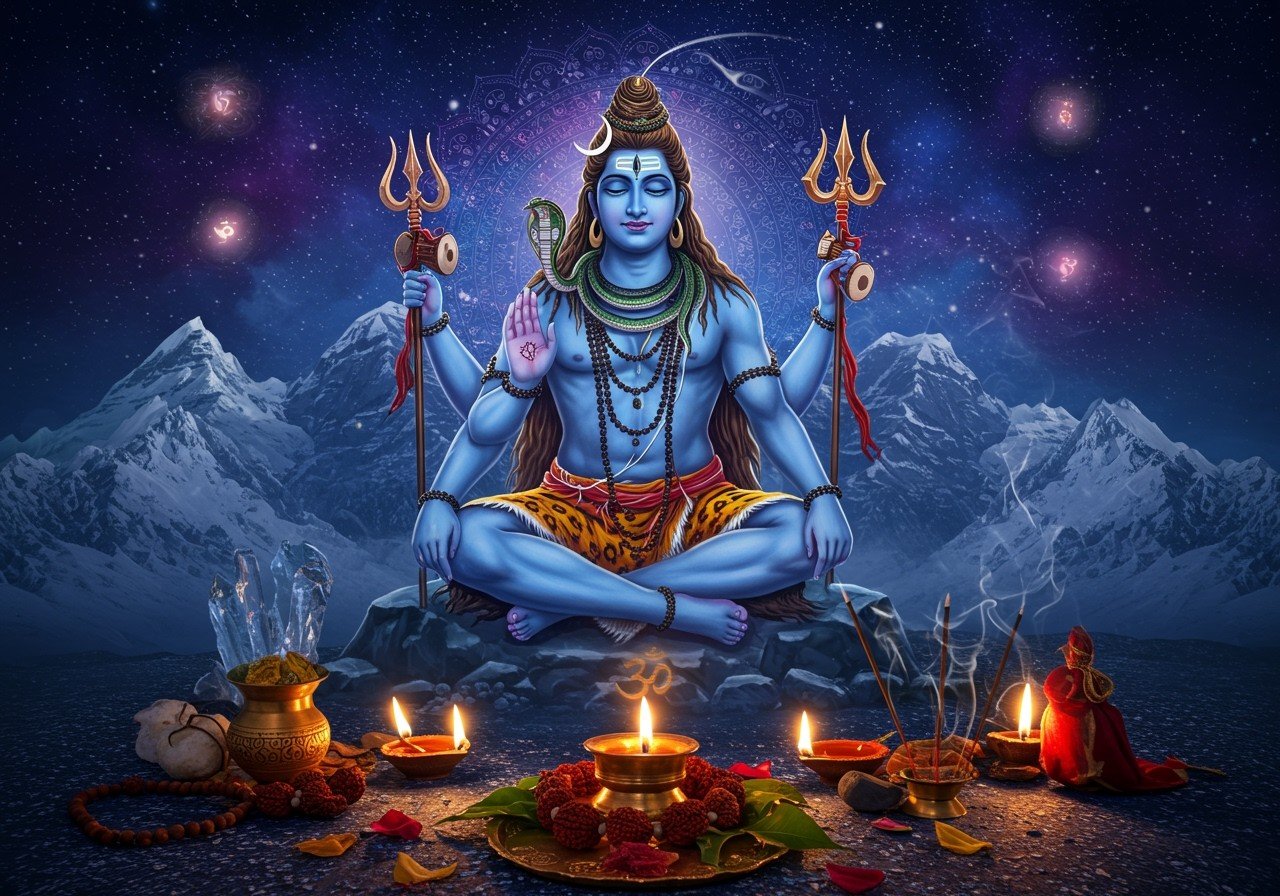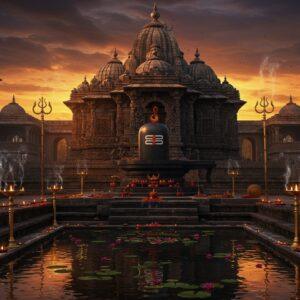
Maha Shivaratri, the Great Night of Shiva, is a profoundly spiritual festival celebrated with immense reverence across India. In 2025, this auspicious occasion falls on Wednesday, February 26th, inviting devotees to immerse themselves in prayer, fasting, and reflection, honoring Lord Shiva’s divine presence.
This blog post delves into the significance of Maha Shivaratri, the rituals involved, the stories behind the festival, and how you can make your observance truly meaningful.
Embracing the Spirit of Maha Shivaratri 2025
As Maha Shivaratri 2025 approaches, we are called to immerse ourselves in devotion, tradition, and deep spiritual understanding. Embrace the rituals with reverence and open your mind to Lord Shiva’s teachings. This sacred night transcends mere rituals; it connects us with divine energy, guiding us towards enlightenment and peace.
Let Shivaratri inspire you to overcome ignorance and embrace clarity, just as Lord Shiva’s cosmic dance embodies creation and destruction. As you chant “Om Namah Shivaya” and offer prayers, feel the spiritual energy that unites you with millions of devotees across the world.
In today’s world, where ancient traditions meet modern conveniences, we can honor these practices with authenticity and ease. Whether you visit a temple or perform puja at home, Maha Shivaratri is a time to seek blessings for yourself and your loved ones. Let this Shivaratri be a transformative journey, guiding you towards balance, peace, and spiritual growth. May Lord Shiva’s blessings be with you always.
The Sacred Rituals of Shivaratri Puja
The Puja Vidhi, the sequence of rituals, begins early morning with the Sankalpa, a solemn vow to observe the fast. Waking up during the Brahma Muhurta (before dawn), you cleanse yourself with a purifying bath and prepare for a day dedicated to Lord Shiva.
- Temple Visit: Visiting a Shiva temple connects you with the divine as you offer prayers to the entire Shiv Parivaar (family), including Lord Shiva and Goddess Parvati. The temple’s energy amplifies your devotion, creating a shared spiritual experience.
- Shivalinga Abhishekam: This sacred bath of the Shivalinga, performed with water, milk, honey, yogurt, ghee, sugar, and Gangajal, purifies and energizes the divine symbol. Each element represents a different aspect of devotion and reverence.
- Offerings: Offer water, Belpatra (Bael leaves), Bhaang, Dhatura, sandalwood, fruits, flowers, and incense on the Shivlinga. Bael leaves, especially, hold immense significance for Lord Shiva, signifying surrender and devotion.
- Mantras and Chanting: Chanting mantras like “Om Namah Shivaya” or the Maha Mrityunjaya Mantra infuses the atmosphere with spiritual vibrations, deepening your connection with the divine. It is believed that chanting these mantras purifies the mind and brings inner peace.
- Night Vigil (Jagran): Many devotees stay awake throughout the night, engaging in bhajans and kirtans dedicated to Lord Shiva. This vigil symbolizes overcoming the darkness of ignorance with the light of devotion and awareness.
- Aarti: The Aarti concludes the puja, a crescendo of light and sound, chanting “Jai Shiv Omkara.” It is a final expression of gratitude and reverence to Lord Shiva.
- Breaking the Fast: The fast is broken the next day after performing the morning prayers. The ideal time to break the fast is between 6:48 AM and 8:54 AM on February 27th.
Looking for authentic puja items? Explore our curated collection of Shivaratri Puja Kits at poojn.in, designed to make your rituals convenient and spiritually fulfilling.
Unveiling the Significance of Maha Shivaratri
Maha Shivaratri, “The Great Night of Shiva,” honors Lord Shiva’s pivotal role in maintaining the cosmic balance. It commemorates his divine union with Goddess Parvati, a symbol of consciousness (Shiva) merging with energy (Shakti), representing perfect harmony.
- Overcoming Darkness: The festival symbolizes the victory of light over darkness, urging us to conquer ignorance through self-discipline and unwavering devotion. This spiritual struggle mirrors our inner journey towards enlightenment.
- Spiritual Awakening: Maha Shivaratri is an auspicious time for spiritual awakening, inner transformation, and the cleansing of past karmas. Devotees believe that through sincere prayer and mantra chanting, they can purify their souls and pave the way for a more fulfilling life.
- Cosmic Dance (Tandava): Lord Shiva’s Tandava, performed on this night, represents the cycle of creation, preservation, and destruction, the continuous flow of cosmic energy. Witnessing or meditating on this dance can bring profound insights into the nature of reality.
- Moksha (Liberation): Praying and fasting on Maha Shivaratri is believed to cleanse devotees of past misdeeds and guide them towards moksha, liberation from the cycle of rebirth. This is a core aspiration for many spiritual seekers.
- Connecting with the Divine: The veil between the human and divine realms is said to be thin on this night. It’s a powerful time to connect with Lord Shiva, seeking his blessings for peace, prosperity, and spiritual growth.
Need everything for your puja? Poojn.in offers a wide range of puja samagri and complete kits, ensuring you have everything you need for a sacred and fulfilling Shivaratri experience.
Exploring the Legends of Maha Shivaratri
Maha Shivaratri is steeped in rich mythology, with captivating stories passed down through generations. Each story offers a different perspective on Lord Shiva’s divine power and compassion.
- Shiva and Parvati’s Marriage: This sacred night commemorates the divine union of Lord Shiva and Goddess Parvati. Their marriage represents the merging of masculine and feminine energies, the foundation of creation.
- Samudra Manthan (Churning of the Ocean): During the Samudra Manthan, the deadly poison Halahala emerged, threatening to destroy the universe. Lord Shiva, in an act of unparalleled self-sacrifice, consumed the poison, holding it in his throat, which turned blue, earning him the name “Neelkanth” (blue-throated). Maha Shivaratri honors this act of supreme compassion.
- Lingodbhava: It is believed that on this day, Lord Shiva manifested as an infinite pillar of light (Lingodbhava), symbolizing his formless and all-pervading nature. This underscores his role as the ultimate reality, the source of all creation.
You can read more about Lord Shiva and other deities on our blog. Explore articles like Shivratri Celebrations, Traditions, and Spiritual Significance and Kerala Temple Architecture: A Detailed Exploration to deepen your understanding of Indian culture and spirituality. You can also explore our extensive selection of divine idols to enhance your home shrine.
FAQs about Shivaratri Puja
What is the significance of Shivaratri Puja? Shivaratri Puja holds immense significance as it honors Lord Shiva, the destroyer of negativity and the source of transformation. The puja is believed to cleanse the soul, bring peace and prosperity, and deepen one’s connection with the divine. It’s a powerful opportunity to seek blessings and guidance on your spiritual journey.
How is Shivaratri Puja performed? The puja involves fasting, bathing the Shivalinga with sacred offerings like milk, honey, and water, and offering Bel leaves, fruits, and flowers. Devotees chant mantras like “Om Namah Shivaya” and engage in night-long vigils filled with prayers and devotional songs.
Why do people fast on Shivaratri? Fasting is a form of self-discipline and purification. It symbolizes detachment from worldly desires and helps focus the mind on spiritual matters. It is believed to enhance the power of prayers and bring one closer to Lord Shiva.
What is the story behind Shivaratri? Shivaratri commemorates several significant events in Hindu mythology, including Lord Shiva’s marriage to Goddess Parvati, his act of consuming poison to save the world, and his manifestation as the Lingodbhava, a pillar of light. These stories highlight his power, compassion, and role as the ultimate reality.
Can Shivaratri Puja be done at home? Absolutely. You can create a sacred space in your home with a Shiva Lingam or image and perform the puja with devotion and reverence. Offerings can be simple and heartfelt, focusing on the intention behind the ritual.
Why is Shivaratri celebrated at night? Shivaratri is celebrated at night because it is believed that Lord Shiva performed his cosmic dance, the Tandava, during this time. The night also symbolizes the darkness of ignorance that we strive to overcome through spiritual practices.
What should I offer during Shivaratri Puja? Traditional offerings include milk, water, honey, Bel leaves (considered particularly sacred to Shiva), fruits, flowers, and incense. These symbolize purity, devotion, and respect for Lord Shiva.
Is Shivaratri only for Hindus? While Shivaratri is a Hindu festival, its message of overcoming darkness and seeking inner peace resonates with many spiritual paths. Anyone drawn to Lord Shiva’s teachings can participate in the observance and benefit from its transformative energy.
Poojn.in is here to support your spiritual journey. Browse our comprehensive guides and informative articles on various pujas and rituals. Find all your puja needs, from divine murtis to complete puja kits, all conveniently available online.


